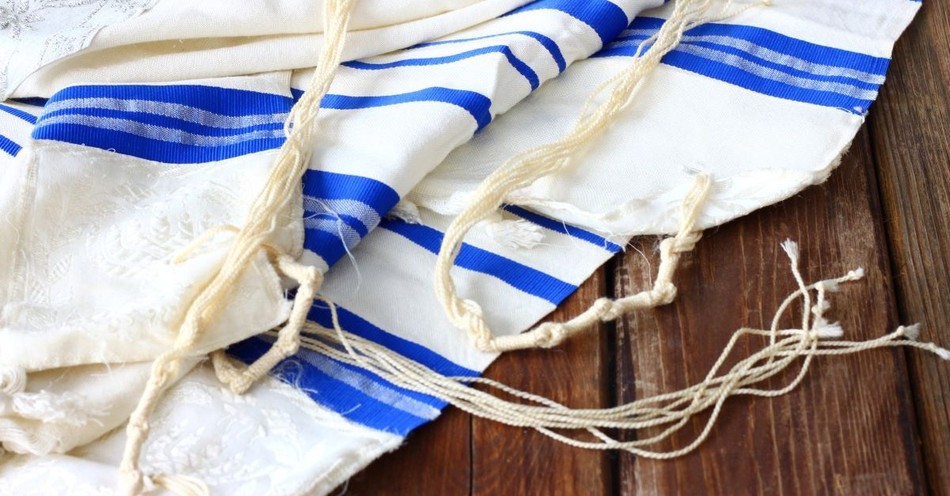You may have heard of prayer cloths while watching a televangelists’ sermon, or maybe someone you know offered you one. If you don’t come from a tradition that talks about prayer cloths, you will wonder, “what is the point of this exactly?” Here are the basics you need to know about prayer cloths, what sets them apart from prayer shawls, and how people often use them.
Is a Prayer Cloth the Same Thing as a Prayer Shawl?
While you might initially think that “prayer cloth” refers to the prayer shawl that Orthodox Jews often wear. The two items can look similar, but they are separate items that fit into two distinct traditions.
The Jewish prayer shawl, properly known as a tallit, is based on Old Testament commandments about the Israelites’ clothing. In Numbers 15:38, God instructs Moses that the Israelites should “make tassels on the corners of their garments throughout their generations, and to put a cord of blue on the tassel of each corner.” Deuteronomy 22:12 reiterates this command: “Make tassels on the four corners of the cloak you wear.”
Observers wear a tallit to synagogue and often give tallits as gifts for landmark events. For example, a Jewish father might give his son a prayer shawl for his bar mitzvah, which officially marks him as a man and, therefore, a fellow synagogue member.
Prayer clothes can be in shawl or blanket form, but just as often, they are small patches of cloth that can fit into a wall or pocket. They may have Bible verses or prayers printed on them or be plain like a handkerchief. Various Protestant churches (usually Pentecostals) use prayer clothes either as a token to show the giver is praying for the sick recipient or as a direct means to pass on healing.
Are Prayer Cloths in the Bible?
There are several Bible references to early Christians receiving the Holy Spirit when existing believers put their hands on them (Acts 8:18-23). Mark 8:22-25 records an instance where Jesus used some of his spit to heal a blind man. There is also an interesting story in 2 Kings 13:21 about a dead man falling into the prophet Elisha’s tomb and returning to life when he touched the skeleton. More generally, there are references throughout the Bible to clothing that signifies a person’s particular station (Joseph’s kingly robe of many colors, the details about Jesus’ robes as king of heaven in Revelation 1:13).
Several passages in the New Testament specifically describe healing being passed on from the clothing of someone following God. In a story mentioned in all three Synoptic Gospels (Matthew 9:20-22, Mark 5:25–34, and Luke 8:43–48), Jesus travels with Jairus to see his sick daughter. On the way to Jairus’ house, a woman struggling with internal bleeding sees Jesus and thinks, “If I only touch his cloak, I will be healed” (Matthew 9:21).
Matthew records that the woman touched the cloak, but it was only afterward when Jesus turned and commended her for her faith was she healed (Matthew 9:22). Mark and Luke record that the woman touched Jesus’ cloak (Luke specifies it was only “the edge of his cloak”) and “…immediately her bleeding stopped” (Mark 5:29, Luke 8:44). According to this account, it was after the woman was healed that Jesus turned to see who had touched him, knowing that “power had gone out from him” (Mark 5:30).
A similar story appears in Acts 19 about the apostle Paul. Luke, traveling with Paul, Silas, and Timothy, records that Paul preached about Jesus in Ephesus for an extended period (Acts 19:10). Luke records that this work had the following effect:
“This continued for two years, so that all the residents of Asia heard the word of the Lord, both Jews, and Greeks. And God was doing extraordinary miracles by the hands of Paul, 12 so that even handkerchiefs or aprons that had touched his skin were carried away to the sick, and their diseases left them, and the evil spirits came out of them.” (Acts 19:10-13).
Whether or not this happened to other apostles is hard to say. It is worth noting that Luke pairs this story about Paul’s cloths with the story of the seven sons of Sceva who tried to do exorcisms in Paul’s name, and it failed dramatically (Acts 19:14-16).
Where Do Modern Prayer Cloths Come From?
Prayer cloths first became popular in America thanks to Joseph Smith, founder of the Church of Latter-Day Saints (also known as Mormonism). A story recorded by Brigham Young states that on July 22, 1839, Smith was traveling with his disciple Wilford Woodruff and healing sick people at the houses he passed. A man requested if Smith could heal his twin infant sons at his home three miles away. Instead, Smith gave Woodruff a red handkerchief and sent him to place it on the sick infants.
Various Mormons followed Smith’s example during the 1830s-1880s. After that period, most Mormons dropped the practice, concerned that it became a folk magic ritual. Around the time that Mormons stopped promoting prayer cloths, Pentecostals and holiness evangelists began using them. Researcher R. Marie Griffith reports that in some cases, prayer cloths were passed from one church to a recently formed one, like a sign of benediction. Griffith also writes that while today prayer cloths still appear in many Pentecostal churches, as a whole, the practice is decreasing. Other denominations, such as Methodist churches, may use prayer cloths too.
Depending on your denomination or your church’s involvement in overseas missions, you may hear stories about missionaries in remote countries who saw miracles accomplished through clothing or other surprising means. In his book A Simple Guide to Experience Miracles, J.P. Moreland argues that since the 1970s, missionaries and experts who track mission work have seen “book of Acts type miracles” rising at a surprising rate. If that is true, stories of unusual healings and methods may increase, especially stories from “the third world,” where Christianity is growing exponentially.
What Do Christians Use Prayer Cloths For?
Depending on the church, people can use prayer cloths for various purposes. Sometimes, pastors or church leaders will pray over a prayer cloth and pass it on to a sick person. This practice has especially become popular among televangelists who teach the prosperity gospel. Sometimes the giver will put oil or some of their sweat onto the cloth for extra effect, like James’s exhortation to anoint a sick man with oil (James 5:14-15) or Jesus using spit to heal a blind man.
In other cases, prayer cloths are more sentimental items to show that other Christians are praying for fellow Christians feeling ill. Melissa Henderson of Crosswalk gives an example of her church praying for her and giving her a prayer blanket while undergoing cancer treatment. Henderson highlighted that she didn’t see the prayer blanket as a magical item bringing healing. Instead, she viewed it as a reminder and comfort that other Christians were praying for her.
Are Prayer Cloths Biblical?
Bible stories about miraculous healings or spiritual gifts are complicated. It’s often hard to tell if a healing method or exhibition of a gift is something that all believers do or something God did with particular people at a specific time (a big point of debate when it comes to speaking in tongues).
The Bible passages shown above describe moments where healing came from clothing or cloths, but neither indicates that this was normal. As noted earlier, Luke immediately follows this story by talking about the seven sons of Sceva, who tried to have power from something associated with holiness. Both using an apostle’s cloth and using an apostle’s cloth involve using something connected to a holy person to get an effect, instead of seeking holiness’ source. The passage also implies that the sons of Sceva used this technique several times, meaning it worked at least once. It’s possible that God allowed their exorcisms to work a couple of times, then left them to their own devices. For all we know, something similar might have happened with Paul’s cloths. We learn that some of Paul’s cloths brought healing during his two-year period in Ephesus. We don’t learn whether they worked more than once or if the healings stopped after Paul left the area.
In short, Acts 19 pairs a success story with a failure story, as if to caution readers from reading too much into the situations. It’s as if Luke is telling readers, “God uses proxy techniques sometimes, but don’t put all your trust into it. Trust directly in God.”
When Paul and his fellow apostles talk about healing in their letters, they don’t advise people to rely on healings from special cloths or other proxy items. When Paul writes to his sick pupil Timothy, he advises him to add something to his diet (1 Timothy 5:23). James encourages believers to pray for each other, to even anoint the sick person with oil, but describes the praying person’s faith as the vital factor (James 5:13-16). Sam Storms highlights how the New Testament epistles also mention times when healing didn’t come, showing that God’s sovereign will ultimately control whether healing happens.
Some people today may have been healed in events that involved prayer cloths. If we assume that happened more often in the early church, and that scholars like J.P. Moreland are right when they say that “Acts type miracles” are becoming more common in our era, then we might even see an increase in such healings. Still, that doesn’t show that prayer cloths are recommended practice, nor does it mean that the cloths do the healing. The Bible is clear that all healing comes from God, and we should devote ourselves to knowing him better, not on proxy items to get miracles or special revelation.
Photo Credit: ©GettyImages/tomertu

This article is part of our prayer resources meant to inspire and encourage your prayer life when you face uncertain times. Remember, the Holy Spirit intercedes for us, and God knows your heart even if you can't find the words to pray.
Prayers for Healing
Morning Prayers
Prayers for Family
Prayers for Surgery
Prayers for Strength
Night Prayers Before Bed
Prayers for Protection
The Lord's Prayer: Our Father



